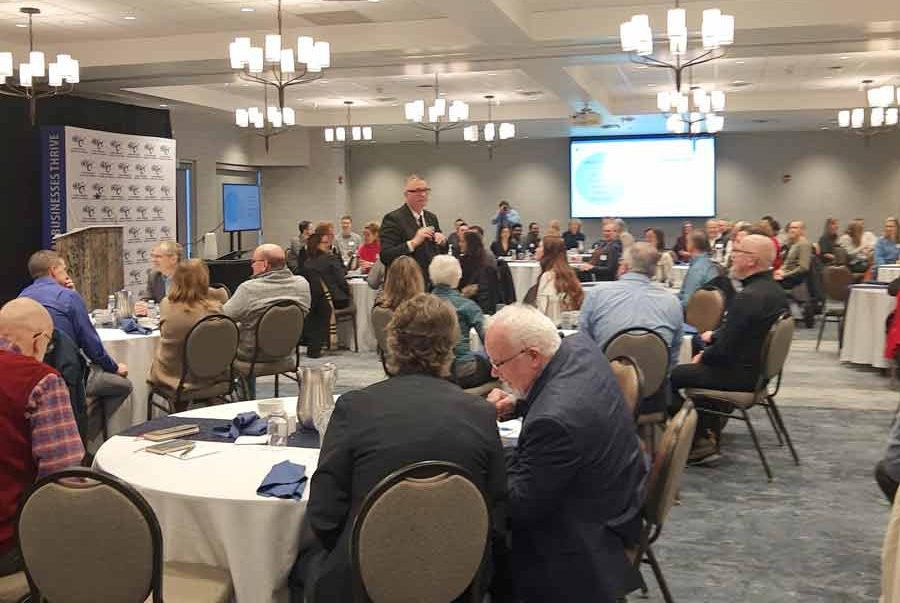ELORA – Last year when Mayor Shawn Watters spoke to the Centre Wellington Chamber of Commerce, he was new to the job and could only speak about his vision for the future.
This time, he has a year under his belt and he shared some numbers with the crowd gathered at GrandWay Events Centre on Jan. 31 for the Mayor’s Breakfast event:
- 101: that’s the number of bylaws council has passed in the past year, Watters said; and
- 982: that’s the number of new housing units council approved in the past year – 225 single family homes, 498 townhouses and 259 rental apartment units.
“Those are big numbers for our community,” Watters said. “We’re growing and soon it’s going to become visual” when those dwellings are actually constructed.
Growth was the dominant theme of Watters’ presentation.
It’s what spawned several road and bridge reconstruction projects last year, including some big ones, like Mill Street East in Elora and Beatty Line in Fergus.
The 2024 budget includes funding for several master and strategic plans such as parking, short-term rentals, parks and recreation, the operations centre and a tourism strategy.
These plans will help inform decisions as they pertain to growth and also decisions as they pertain to finances.
For example, another arena, if that’s what the study indicates, will cost money. Best to start setting some aside now.
Watters also talked about the province’s decision to expand the urban boundary of Centre Wellington.
Wellington County was in the midst of a municipal comprehensive review, so word from the province last spring that Centre Wellington’s boundary had been expanded came as a surprise to the county and the township.
A few months later the province reversed that decision.
“One day we were working through the plans, then the province reconfigured our boundary,” Watters said.
“And then the province reversed that. It was challenging for us as we had already initiated some plans.”
This council will now get to weigh in on potential boundary expansions, taking into consideration resources like the Grand River, water supply and other matters that hadn’t been considered when the province initially announced changes.
Watters said the most valuable asset Centre Wellington has is agriculture. It is also the township’s biggest industry and needs careful consideration when it comes to growth.
“We can’t think of it as vacant land,” he added. “This is how we feed the province. It’s the most important land we have.”
Dan Wilson, the township’s chief administrative officer, said the township thinks it will need to add 400 hectares – about 1,000 acres – to the urban boundary to meet the provincial goal of growing to 60,000 people by 2051.
But requests from developers that have come to the township total 3,000 acres.
“It’s a tough one,” Watters said. “This is what staff and council have to balance.
“Not all of the developer community will get in. There will be some folks who won’t be happy.”
To a question on density in reaching those growth targets, Watters said intensification is necessary.
That includes everything from granny flats in backyards, infill projects and allowing higher buildings, as well as smaller homes with smaller lots.
To a question on affordable and rent-geared-to-income housing, Watters said a diversity of housing stock will help but that’s a question for federal and provincial governments, who have more control over the purse strings.
Watters said a growing population can mean opportunity for businesses.
“It’s for you as business leaders to judge and decide. Politicians can only give the lay of the land.”
The Fergus Business Park is now fully serviced and industrial lots are up for sale.
Watters applauded the previous council for having the foresight to get the project off the ground because along with residential growth comes the need for local employment.
Watters said the Centre Wellington contingent had meetings with the Minister of Transportation and the Minister of Municipal Affairs at the recent Rural Ontario Municipal Association (ROMA) conference, where they spoke about the need for a Highway 6 bypass.
The more Fergus grows, the more congested Highway 6/St. David Street will become, he said, so the time for a solution is now.
The ministry also needs to work with builders with projects on Highway 6 to allow them access to, from and across the highway while projects are being built.
“I think they heard us. I feel something good will come of it,” Watters said.




